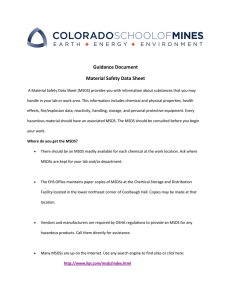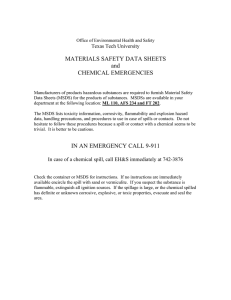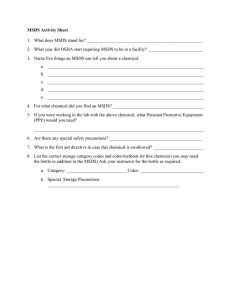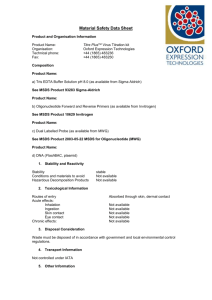What is a Material Safety Data Sheet (MSDS)
advertisement
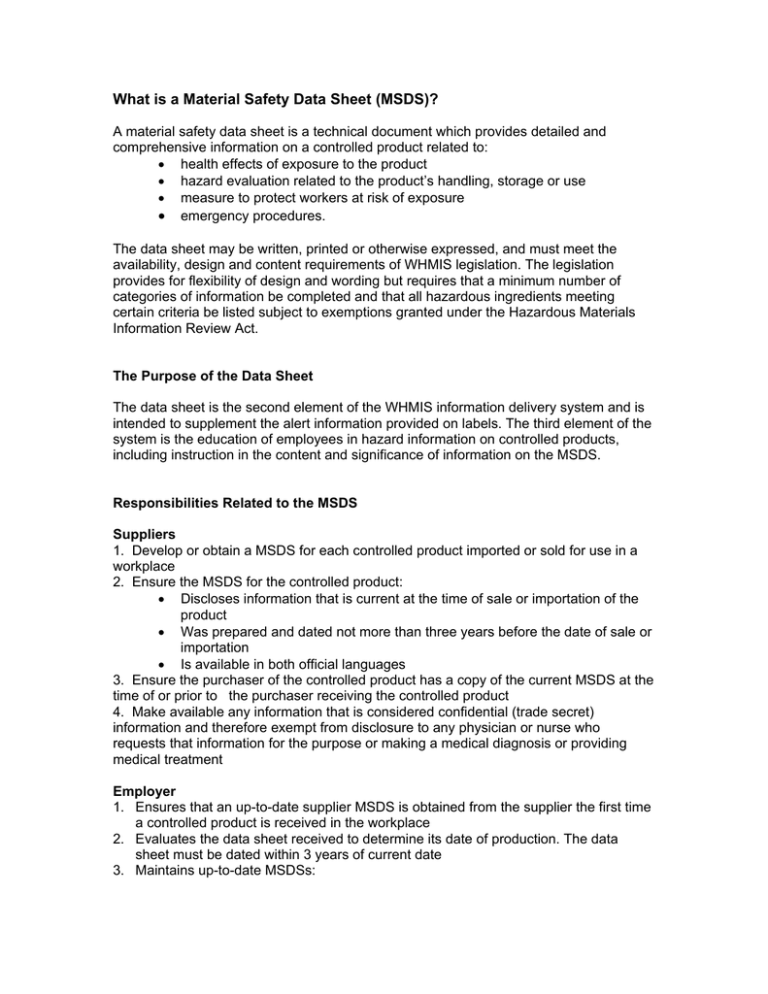
What is a Material Safety Data Sheet (MSDS)? A material safety data sheet is a technical document which provides detailed and comprehensive information on a controlled product related to: health effects of exposure to the product hazard evaluation related to the product’s handling, storage or use measure to protect workers at risk of exposure emergency procedures. The data sheet may be written, printed or otherwise expressed, and must meet the availability, design and content requirements of WHMIS legislation. The legislation provides for flexibility of design and wording but requires that a minimum number of categories of information be completed and that all hazardous ingredients meeting certain criteria be listed subject to exemptions granted under the Hazardous Materials Information Review Act. The Purpose of the Data Sheet The data sheet is the second element of the WHMIS information delivery system and is intended to supplement the alert information provided on labels. The third element of the system is the education of employees in hazard information on controlled products, including instruction in the content and significance of information on the MSDS. Responsibilities Related to the MSDS Suppliers 1. Develop or obtain a MSDS for each controlled product imported or sold for use in a workplace 2. Ensure the MSDS for the controlled product: Discloses information that is current at the time of sale or importation of the product Was prepared and dated not more than three years before the date of sale or importation Is available in both official languages 3. Ensure the purchaser of the controlled product has a copy of the current MSDS at the time of or prior to the purchaser receiving the controlled product 4. Make available any information that is considered confidential (trade secret) information and therefore exempt from disclosure to any physician or nurse who requests that information for the purpose or making a medical diagnosis or providing medical treatment Employer 1. Ensures that an up-to-date supplier MSDS is obtained from the supplier the first time a controlled product is received in the workplace 2. Evaluates the data sheet received to determine its date of production. The data sheet must be dated within 3 years of current date 3. Maintains up-to-date MSDSs: 4. 5. 6. 7. As soon as practical but no later than 90 days after new hazard information becomes available to the employer At least every three years Ensures a copy of all data sheets which are required for the workplace are made readily available at the worksite to: Workers who may be exposed to the controlled product The occupational health committee (OHC) Note: The MSDSs may be made available on a computer if the employer takes all reasonable steps to keep the terminal in working order, makes the data sheets readily available to the employee and provides training in accessing the computer stored data to the employee. Ensure that the employee who works with a controlled product or in proximity to a controlled product is instructed in: The content required on the MSDS The purpose and significance of information contained in it Instruction must ensure that employees know procedures for the safe use, storage, handling and disposal of controlled products including procedures in the event of an emergency involving a controlled product. Provide confidential (trade secret) information to a doctor or nurse who request this information for purposes of making a medical diagnosis or rendering medical treatment in an emergency The employer can produce data sheets in order to provide additional information or alter the format used as long as there is no less information provided than the original supplier MSDS contained Worker Following training by the employer: 1. Follows the safe work or preventative measures as instructed by the employer 2. Knows where the sheets are located and how to find pertinent information on safe use and first aid measures Material Safety Data Sheet Content A supplier material safety data sheet must provide at least nine categories or sections of content and approximately sixty items of information distributed among those categories. An MSDS must be reviewed at least every three years. The categories must have the following similar headings: I. Hazardous Ingredients This section will include: The chemical names and concentrations concerning the hazardous ingredients The LD 50 and LC50 indicate the short term toxic potential CAS number which is useful in locating more information especially if the product is known by numerous names\ II. Preparation Information This section includes: The name address and telephone number of who prepared the MSDS The date the MSDS was prepared o If more than three years old, it must be updated III. Product Information This section: Identifies the product by the name on the supplier label Provides the chemical name, family and formula (including molecular weight) Lists the product identifiers, manufacturer and supplier names, addresses and emergency telephone numbers IV. Physical Data This section includes information indicating how it looks and how it will behave when it is used, stored, spilled and how it will react with other products indicated through: The state it is in e.g. liquid The odour and appearance of the product The specific gravity, vapour density, evaporation rate, boiling point and the freezing point The vapour pressure, the higher the concentration the higher the possible air concentration The odour threshold, which is the lowest airborne concentration of a chemical that can be perceived by smell The pH reflecting the corrosive or irritant nature of the product V. Fire and Explosion Hazard This section describes: The temperature and conditions that can cause the chemical to catch fire or explode o UEL (upper explosion limit) or UFL (upper flammable limit) will indicate the highest concentration of a substance in the air that will produce a fire or explosion when a source of ignition (heat, spark or flame) is present o LEL (lower explosion limit) or LFL (lower flammable limit) will indicate the lowest concentration of a substance in the air that will produce a fire or explosion when a source or ignition is present o From the LEL to the UEL, the mixture is explosive. Below the UEL the mixture is too lean to burn; above the LEL the mixture is too rich to burn. However, concentrations above the UEL are still very dangerous because if the concentration is lowered (by introducing fresh air), it will enter the explosive range Means of extinction including the type of fire extinguisher required Personal Protective Equipment required for fire fighting Some of the storage requirements however more of this information is found in the reactivity data section VI. Reactivity Data: This section describes: The chemical stability of the product and its reactions to light, heat, moisture, shock and incompatible materials Storage requirements based on the reactivity or instability of the product Incompatible products that must not be mixed or stored near each other The need for disposal before they become extremely reactive VII. Toxicology Properties: This section describes: The harmful effects of exposure How the product is likely to enter the body and what effects it has on the organs in the body The short-term (acute) and long-term (chronic) health effects from exposure to the product The exposure limits, which indicates the maximum concentration in air of a hazardous substance (gas, vapour, dust, mist, fume) to which nearly all workers (without personal protective equipment) can be repeatedly exposed without adverse health effects. Exposure limits are expressed in three ways: o TWA (time weighted average) indicating the maximum average concentration to which workers can safety be exposed for a normal 8hour workday or 48-hour workweek o STEL (short-term exposure limit) indicating the maximum concentration to which workers can safely be exposed for a period of up to 15 minutes. The STEL is higher than the TWA. It may not be sustained more than four times a day o C (ceiling) describes the concentration that may not be safely exceeded at any time, even for an instant. The C is higher that the STEL If these limits are to be exceeded, the worker must use recommended personal protective equipment. Exposure limits are expressed as ppm for gases and vapours and as mg/m3 for dusts, fumes and mists Note these limits may be expressed as OEL, PEL and TLV Information used to assess the health problems of any employee who uses the chemical and determine if that worker’s problems are related to the chemical VIII. Preventative Measures: This section provides: Instruction for the safe use, handling and storage of the product The personal protective equipment or safety devices required The steps for cleaning up spills Information on the waste disposal requirements IX. First Aid Measures: This section describes: Specific first aid measures related to acute effects of exposure to the product First aid steps in the correct sequence Information to assist in planning for emergencies The MSDS may contain additional sections providing further information related to the specific product. Location of the MSDSs Hard copy readily available Computer terminals Employees and others must know where the MSDS is and how to use them MSDS revisions are required every 3 years or sooner if new product information is available. Trade Secret Exemptions Information may be withheld to protect industries’ right to protect confidential business information. This information is referred to as trade secrets. The producer of the product can withhold: The name and concentration of any ingredient Name of relevant toxicological studies Once a claim if filed to withhold information the product label must state: Date the exemption filed Claim registration number The MSDS must state: That an exemption has been granted Date it is granted Registry number Product hazards Medical Access Doctors and nurses can access withheld information however this information remains confidential.
